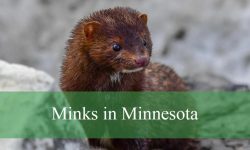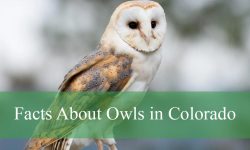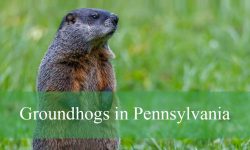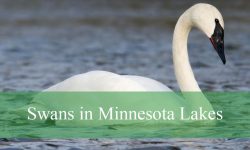Not surprisingly, a number of bird species call the huge state of California home. Some of these species are periodic visitors, but many of them live there permanently. These diverse species, which include the striking Indigo Bunting and the vibrant Western Bluebird, add a splash of color to the Californian landscape with their unique characteristics and habitats.
This article will look at and provide information on each of the 17 species of blue birds that are found in California.
Different Types of Blue Birds in California
Western Bluebird
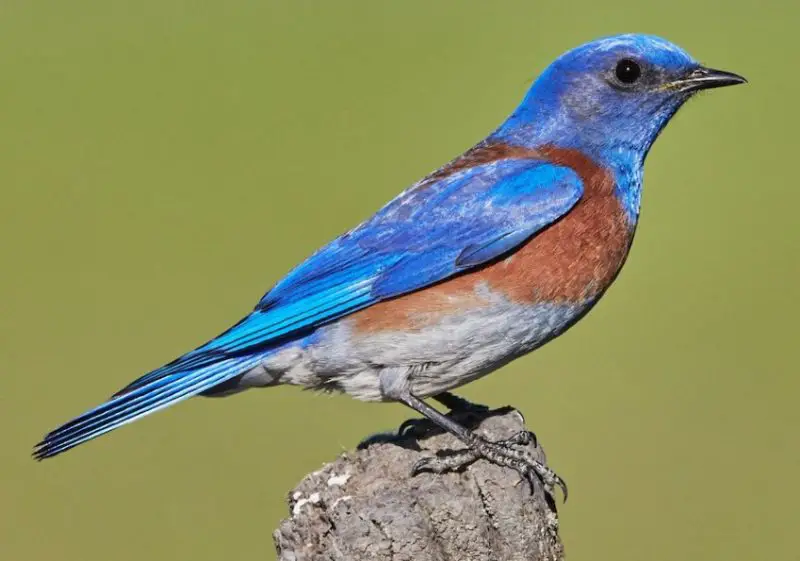
With its striking colors and distinctive nesting behaviors, the Western Bluebird (Sialia mexicana) is the most prevalent species of bluebird in California. Males have a reddish-orange chest and a deep blue head and back, while females and juveniles are more muted, with gray-brown upperparts and a lighter gray bottom. These birds compete with House Sparrows and European Starlings for the nest holes and nest boxes that they use.
Even though their numbers declined in the latter part of the 20th century, nest box conservation initiatives have allowed them to repopulate, and now they may be seen all year round throughout the Golden State.
Lazuli Bunting
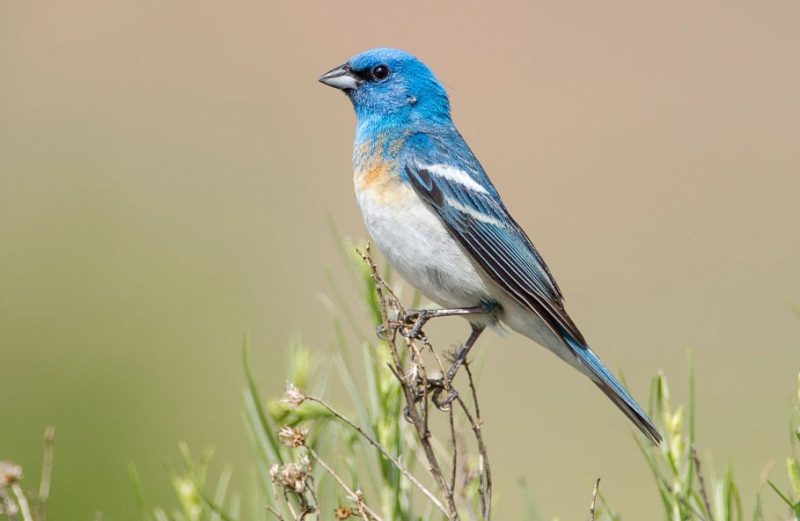
Lazuli Buntings (Passerina amoena) are beautiful songbirds found in the western USA. They breed in summer in northern California. Male adults have a pale blue neck, rump, and hood. They also have dark gray wings with a white wingbar, a chestnut orange breast, and a white belly. The buff-brown females have a pale blue rump and black wings.
During the breeding season, which runs from May to August in northern California, these buntings can be found there before their winter migration to Mexico. They are a striking sight in the warmer months, with their vivid hues and seasonal presence.
Indigo Bunting
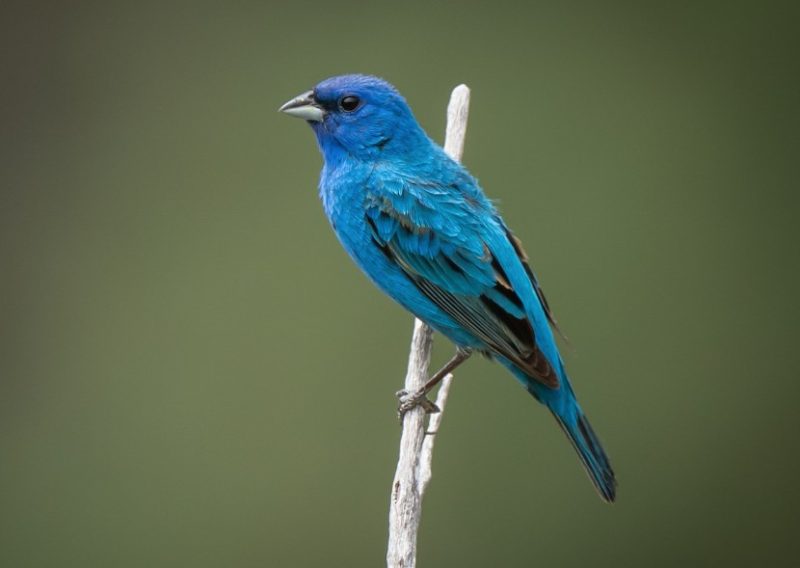
A little songbird with eye-catching colors is the Indigo Bunting (Passerina cyanea). Males in June are almost completely indigo blue, with darker brownish tail feathers and wingtips. With pale brown upperparts and creamy white underparts, females and youngsters are less noticeable. Only in the southeast of the state, in parks, gardens, and woodland margins, can one spot this uncommon bird in California.
Particularly in the spring, it frequents bird feeders that provide seeds. The males sing from their perches in the trees during breeding season. Only present in California during the summer, the Indigo Bunting is strictly migratory, spending the winter in Central and South America before departing in tiny flocks in the fall.
Blue-gray Gnatcatcher
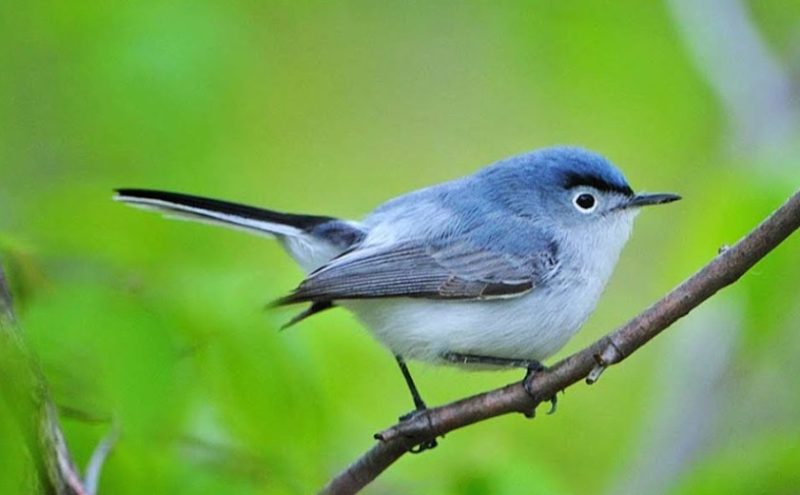
With its long tail, the Blue-gray Gnatcatcher (Polioptila caerulea) is similar to a warbler. Male adults have lighter gray underparts and a black tail with a white border. Their upperparts are blue-gray. Birds that are female or young have a white eyering and are grayish top and light gray below. In temperate North America, this bird breeds from early May through August.
A portion of its population migrates; whereas northern inhabitants spend the winter in the southern United States and Central America, populations from the southeast live there year-round. The Blue-gray Gnatcatcher is a unique and endearing sight, easily recognized by its long tail, which is frequently cocked upward.
Barn Swallow
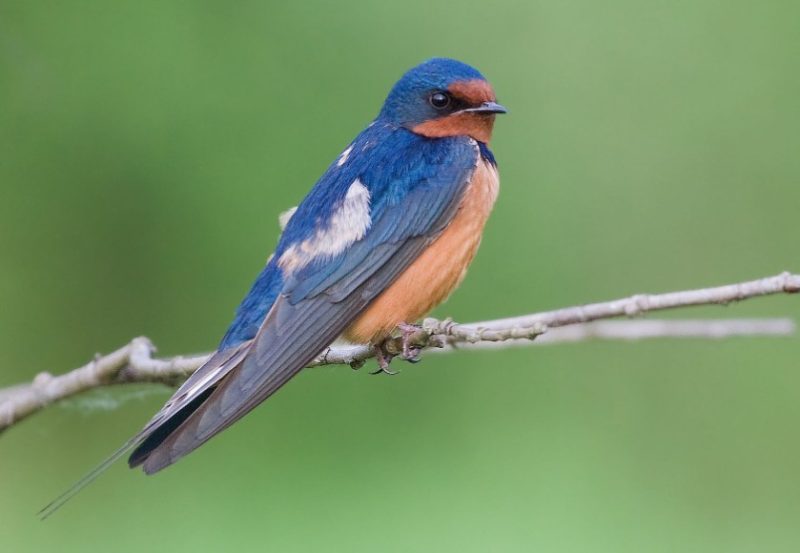
The barn swallow (Hirundo rustica) is a common bird in many different environments found in North America south of the Arctic Circle. Its underbelly is reddish-orange, with a chestnut orange forehead and throat and a pale reddish-orange belly; its iridescent upperparts glisten dark blue in the sunlight. A crucial characteristic that sets them apart is their deeply forked tail, even though young swallows have duller feathers and shorter, less forked tails.
Barn Swallows have been known to nest in hollow trees and caves, but these days they prefer barns, bridges, and structures. They are common in California, but as their foraging and breeding grounds disappear, so does their population. They spend the winter in Central and South America, feeding on flying insects.
Purple Martin

Male Purple Martins (Progne subis) have iridescent dark purplish-blue plumage with black wings and tails, making them the largest martin species in North America. Juveniles and females have beige-white underparts and a light gray upper body. Interestingly, the only martin species lacking a light-colored belly is the male Purple Martin. They used to nest in tree cavities, but these days they favor artificial environments and frequently form colonies with several hundred couples.
Expert hunters from the air, their main meal is dragonflies, which they obtain by skimming the surface of the water while in flight. They migrate, spending the winter in South America, where they congregate in enormous roosts. Place a Purple Martin home in your yard to draw them in.
Mountain Bluebird
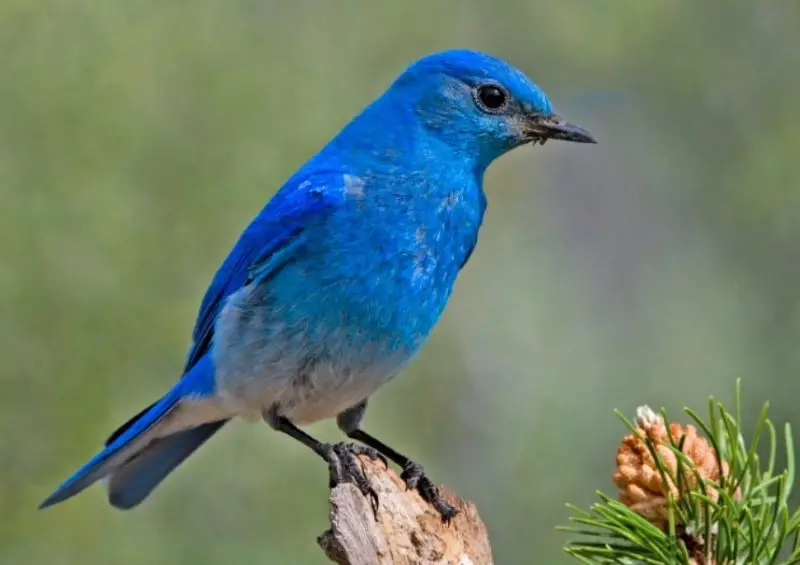
Living in alpine areas, the Mountain Bluebird (Sialia currucoides) and Western Bluebird sometimes cross paths. Male adults are remarkably bright blue in color, with a pale cream belly and a darker back and breast. The females have light blue feathers on their wings and rump, and they are buff gray in color. Nesting year-round in the northern regions of the state, they are the only fully blue bird found in California.
They go about in the winter and possibly visit feeders that provide mealworms or berries. It takes several boxes to draw in Mountain Bluebirds because they are apprehensive about being replaced by more combative avian species.
California Scrub-Jay
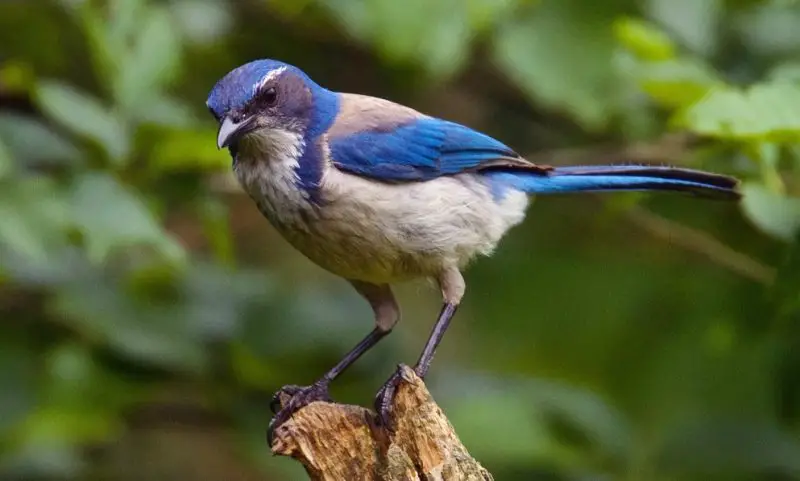
Formerly classified as a subspecies of the Western Scrub-Jay (Aphelocoma californica), the California Scrub-Jay was identified as a separate species in 2016 and was distinguished from the inland Woodhouse’s Scrub-Jay. This jay is the most common in California, found mostly along the Pacific Coast and common everywhere but in the Mojave Desert.
Both sexes have a light gray belly and dark gray shoulders, with an azure blue upper head, wings, and tail. Their throat is white with gray streaks, which contrasts with their blue body. They live all year round in shrublands and moderately wooded areas, so you can see them often in a variety of Californian environments.
Steller’s Jay
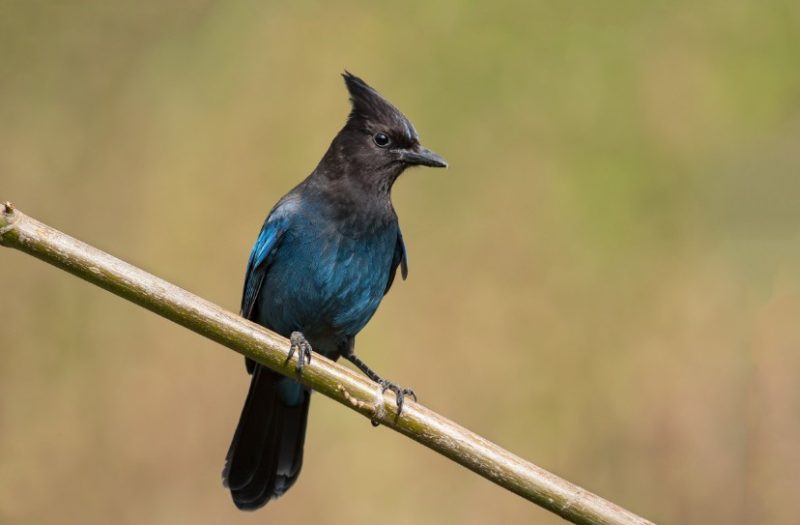
The medium-sized Steller’s Jay (Cyanocitta stelleri), which belongs to the jay family, is easily identified by its eye-catching crest and dark blue body. While it is rare in the more dry southern regions, such as the Mojave Desert, it is common in northern California. The head, nape, and upper back of both males and females are dark gray to blackish, while the remainder of the body is a dark navy blue color.
Within their breeding territory, these jays live year-round, although occasionally they will make abrupt excursions southward, showing up in places they would not normally be seen.
Pinyon Jay

Unlike other jays, the Pinyon Jay (Gymnorhinus cyanocephalus) is a vivid blue songbird with a slim bill and body. Males and females are light blue, with the belly being whiter and the head being darker. In western California’s rugged pinyon-juniper forests, this uncommon breeding bird lives. Since they live in colonies with dozens of pairs for nesting, if you see one, there are probably many more nearby.
Depending on the season, pinyon jays eat fruits, insects, and pine seeds. They have a noticeable presence in their habitat due to their remarkable coloring and social nesting practices.
Belted Kingfisher

With its grayish-blue upperparts, the Belted Kingfisher (Megaceryle alcyon) bears resemblance to Blue Jays; yet it is often found near bodies of water. Male adults are nearly all teal blue above, with a white belly, a grayish breast band, and a white collar that divides the cap from the body. The flanks of females are rufous orange. Belted Kingfishers dive into the water headfirst to catch fish, and they prefer to live near lakes and rivers.
They live year-round in southern regions, including California, and are partially migratory. Northern inhabitants travel south during hard winters. This blue-colored bird hardly ever goes far from water to feed, mostly on small fish.
Blue Grosbeak
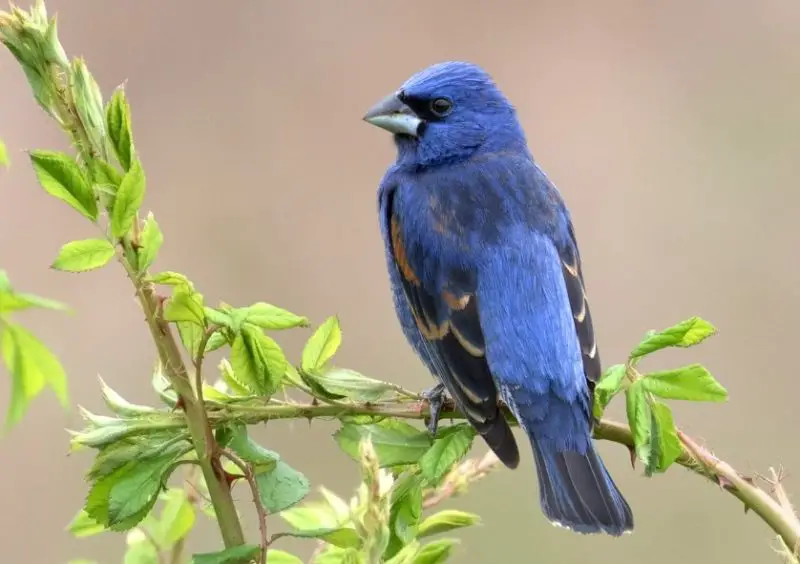
The magnificent Blue Grosbeak (Passerina caerulea) is a songbird with a big, conical beak. Male adults are almost totally dark blue, with black face feathers and two brown wingbars. Female underparts are pale, and they are brownish-gray. Although it breeds in southern California, this grosbeak spends the winter in Central America.
Its preferred habitats are grasslands and shrublands, with lots of bushes scattered throughout. During its breeding season in California, the Blue Grosbeak is easily recognized due to its unique wingbars and distinctive male colors.
Great Blue Heron
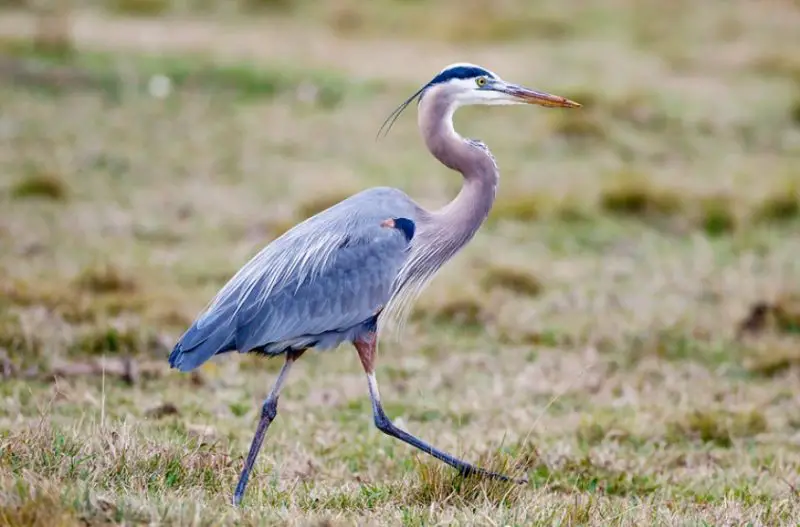
With a 6-foot wingspan, the Great Blue Heron (Ardea herodias) is one of the most abundant herons in California. It can be observed year-round. With a white throat, eye stripe, and dark gray wing feathers, its color is mostly blue-gray. This bird waits patiently to capture prey with its long, yellow bill as it wades through the shallow waters of lakes, marshes, and ponds in search of small fish and aquatic creatures.
It also searches grassy places, golf courses, and meadows for rodents to eat. It is a year-round resident of California and is not migratory; however, it may relocate to the south if the state’s northern waters freeze in the winter.
Little Blue Heron

While juveniles are completely white during their first year of life and can be identified by their dark, pointed bill and green legs, adult Little Blue Herons (Egretta caerulea) are slate blue. Only a small, isolated population in the southernmost region of the state of California is home to these tiny herons, making them extremely uncommon there.
The Little Blue Herons of California are year-round residents, in contrast to their migratory relatives in the north. They eat crustaceans, mollusks, and tiny fish, with crayfish making up a sizable portion of their diet. They hunt in shallow waters and are rarely spotted outside of water, preferring to live in aquatic environments.

